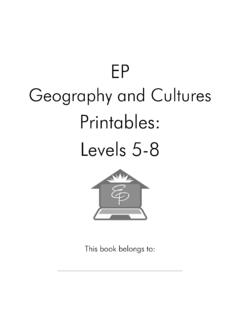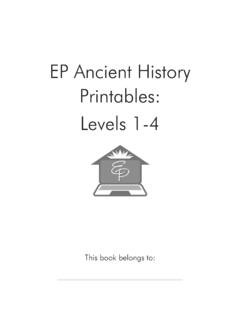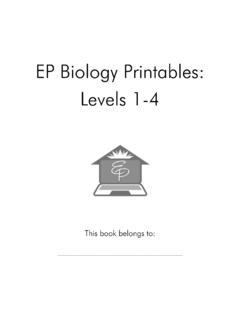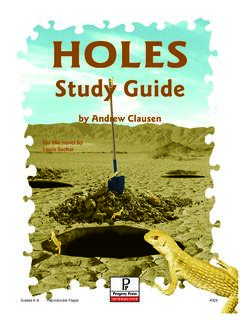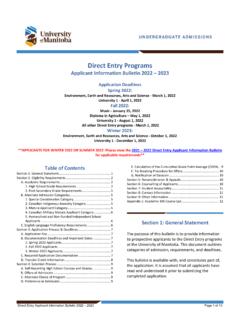Transcription of EP Zoology Printables: Levels 1-4 - All-in-One Homeschool
1 EP Zoology Printables: Levels 1-4. This book belongs to: _____. This book was made for your convenience. It is available for printing from the Easy Peasy All-in-One Homeschool website. It contains all of the printables from Easy Peasy's Zoology course. The instructions for each page are found in the online course. Easy Peasy All-in-One Homeschool is a free online Homeschool curriculum providing high quality education for children around the globe. It provides complete courses for preschool through high school graduation. For EP's curriculum visit EP Zoology Printables: Levels 1-4. Copyright 2020 All rights reserved. This workbook, made by Tina Rutherford with permission from Easy Peasy All-in-One Homeschool , is based on the Zoology component of Easy Peasy's curriculum. For EP's online curriculum visit This book may not be reproduced in whole or in part in any manner whatsoever without written permission from Easy Peasy.
2 ISBN: 9798640334159. First Edition: June 2020. Lesson Zoology 2. Levels 1-4. Sort Cut out the various animal cards and sort them based on whether they lay eggs (oviparous) or give birth to live young (viviparous). frog ape bear flamingo grasshopper alligator pig dove raccoon snake rabbit platypus duck elephant tortoise stork Lesson Zoology 2. Levels 1-4. Oviparous (lay eggs). Viviparous (live young). Animal Classification Lapbook Lesson Zoology 6. Levels 1-4. Classifying Living Things Cut out the rectangle as one piece and fold on the dotted line. Inside (opposite the glue here side), write the divisions of taxonomy in order from biggest to smallest: kingdom, phylum, class, order, family, genus, species. If you're going to glue your lapbook to a file folder or poster board you can do that now or wait until you've completed all of the pieces.
3 (glue here). Classifying living things Lesson Cut out the rectangle as one piece. Fold the left side in (on the line at A), and fold the right side in (on 7. the line at B). Cut on the dotted lines so that 1, 2, 3, and 4 are strips you can open to the fold. On the inside (opposite glue here ), write the four main classes of invertebrates.: echinoderms, annelids, mollusks, and arthropods. A. 1 Four Main Invertebrate 2. Invertebrates (glue here) Classes 3. 4. B. Levels 1-4. Zoology Lesson Cut out the rectangle as one piece. Fold the left side in (on the line at A), and fold the right side in (on 7. the line at B). Cut on the dotted lines so that 1, 2, 3, and 4 are strips you can open to the fold. On the inside (opposite glue here ), write the five classes of vertebrates: mammals, reptiles, amphibians, birds, and fish.
4 A. 1 Five Main 2 Vertebrate Vertebrates 3 (glue here) Classes 4. 5 B. Levels 1-4. Zoology Lesson Zoology 7. Levels 1-4. Invertebrates and Vertebrates Cut out the rectangle as one piece and fold on the center line. Cut on the dotted line to the center fold. Inside (opposite the glue here side), write vertebrate and invertebrate under the correct flap. (glue here). Does not Has a have a backbone backbone Lesson Zoology 8. Levels 1-4. Reptiles and Fish Cut out the rectangles and fold on the dotted line. Inside (opposite the glue here . side), write characteristics of reptiles (dry skin or scales, breathe air, lay eggs) and fish (fins, tail, scales, use gills to breathe underwater). Reptile (glue here) characteristics Fish (glue here) characteristics Lesson Zoology 8. Levels 1-4. Mammals Cut out the hexagons and stack them with the mammals piece on top.
5 Staple and add to your lapbook. covered in Mammals hair or fur give birth to feed milk to live young their babies breathe air with lungs Lesson Zoology 9. Levels 1-4. Birds Cut out the eggs and write the characteristics of birds (covered in feathers, have claws, aws, have two wings, lay eggs). Bird characteristics Lesson Zoology 9. Levels 1-4. Amphibians Cut out the lily pads. Write or glue the amphibian facts onto them. Amphibian lay eggs in characteristics water move to land as adults smooth and wet or slimy skin Lesson Zoology 10. Levels 1-4. Echinoderms and Annelids Cut out the rectangles and fold on the dotted line. Inside (opposite the glue here . side), write characteristics of echinoderms (several arms or spines around a central body, usually symmetrical, hard skin) and annelids (long cylindrical body, segmented).
6 Echinoderm (glue here) characteristics Annelid (glue here) characteristics Lesson Zoology 10. Levels 1-4. Mollusks and Arthropods Cut out the hexagons and stack them with the mollusks piece on top. Staple and add to your lapbook. Do the same with the diamonds and the arthropod pieces. Mollusk characteristics soft body; can be covered by hard shell in water: swim on land: by pushing move on a water out of foot their bodies hard Arthropod exoskeleton characteristics and jointed limbs Lesson Zoology 12. Levels 1-4. Endangered Species 12. Cut the pages on the dotted lines and place them in this pattern: 3 4 Using a single six-sided die and whatever markers you can gather (coins, different rocks, pawns from other games, etc.), take turns rolling and moving the number on the die. Follow the directions on the square you land on.
7 Requested facts can be found throughout the board. Can you all get to the end before you go extinct? Tell someone a fact about the Tell someone a pronghorn. START fact about the goliath frog. - The black-ffaced impala is a rare subspecies of impala, making it desirable to trophy hunters. - Impalas are known for their leaps which can span 30 feet. - Herds range in size from 3 to 15. and are found in Africa. Tell someone a fact about the Tell someone a cheetah. fact about any Tell someone mammal. three threats to endangered animals. 1. Lesson Zoology 12. Levels 1-4. Tell someone a Your species moves fact about an Tell someone a from the threatened African animal. fact about the list to the endangered impala. list. Lose a turn! Tell someone a fact about a non- mammal. - The Sonoran pronghorn is one Tell someone of the most endangered animals in three threats to the United States.
8 Endangered - The pronghorn is the fastest land animals. animal in North America. - Drought is its biggest threat. Tell someone a Tell someone a fact about the fact about the cockatoo. blue whale. Move forward Catch a poacher three spaces and in the act and read that square. save an elephant. Roll again! 2. Lesson Zoology 12. Levels 1-4. 3. Tell someone a fact about the goliath frog. Tell someone a fact about a non- mammal. Tell someone a fact about the impala. - The blue whale is the largest animal known to have existed. - Whaling (hunting whales for their usable products) is its biggest threat. - The white cockatoo is one of - Seen regularly off the coast of several endangered cockatoo California. species. - Its beauty makes it desirable for the pet trade - Found in the Philippines, Indonesia, and Australia.
9 FINISH Tell any fact that hasn't been told Tell someone three threats to endangered Recite three things so far to avoid animals. you've learned and your extinction! species will survive! Lesson Zoology 12. Levels 1-4. 4. Tell someone a fact about the Tell someone a blue whale. fact about an African animal. Tell someone a Discover a new fact about the population of an cockatoo. endangered species: roll again! Tell someone a - The goliath frog is the largest fact about the living frog on earth. cheetah. - It is found in a few remote places such as Equatorial Guinea. - Its biggest threat is its desirability as an exotic pet. Tell someone a fact about a mammal. Tell someone a fact about a non- African animal. Make it to the finish space on Tell someone a your next turn or fact about the become EXTINCT.
10 Pronghorn. Lesson Zoology 17. Levels 1-4. Food Web Use the food web to answer the questions. What are the producers in this food web? What are the consumers in this food web? What does the eagle eat? What eats the grass? What eats the mouse? Lesson Zoology 20. Levels 1-4. Food Chain Use the words above each paragraph to fill in the blanks. food trees sun energy bottom Plants and can be found at the of the chain. Unlike the foods above them, plants get from the . herbivores caterpillars plants cattle eaters The at the bottom of the food chain are eaten by or plant . Some examples of these would be and . carnivores prey predators top cheetah At the of the food chain are or meat eaters.. These animals are also known as because they eat other animals, known as their . An example of this animal type would be a.



